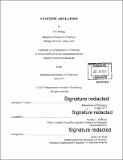| dc.contributor.advisor | Bradley L. Pentelute. | en_US |
| dc.contributor.author | Zhang, Chi, Ph. D. Massachusetts Institute of Technology, Department of Chemistry | en_US |
| dc.contributor.other | Massachusetts Institute of Technology. Department of Chemistry. | en_US |
| dc.date.accessioned | 2017-12-05T19:13:16Z | |
| dc.date.available | 2017-12-05T19:13:16Z | |
| dc.date.copyright | 2017 | en_US |
| dc.date.issued | 2017 | en_US |
| dc.identifier.uri | http://hdl.handle.net/1721.1/112448 | |
| dc.description | Thesis: Ph. D., Massachusetts Institute of Technology, Department of Chemistry, 2017. | en_US |
| dc.description | Cataloged from PDF version of thesis. | en_US |
| dc.description | Includes bibliographical references. | en_US |
| dc.description.abstract | Proteins are the chemical and biological foundation of life. The longstanding goals of chemical biology are to understand the structure and function of proteins and to use these biomolecules for applications in chemistry, biology, medicine, and material science. To achieve such goals, highly efficient, selective, and robust chemical reactions are desired to modify proteins. For decades, cysteine-based reactions with maleimides and alkyl halides are the primary methods for selectively tagging proteins with fluorescent dyes, affinity and radio labels, drug molecules, and polymers and nanocomposites. These traditional reactions generate sulfur-sp³ carbon bonds between the cysteine thiol and the labeling reagents. The goal of this thesis is to develop new cysteine arylation reactions to generate sulfur-sp² carbon bonds on proteins. These reactions are used to make novel peptide and protein therapeutics. Two mechanistically complementary approaches are developed to arylate cysteine thiol. First, through a nucleophilic aromatic substitution (SNAr) mechanism, fluorinated aromatic reagents are used for the regioselective arylation of a single cysteine in the presence of many. An enzyme-tag pair (glutathione S-transferase (GST) and glutathione (GSH)) and a self-labeling short peptide (Phe-Cys-Pro-Phe, the 7-clamp) are respectively developed to recognize the fluorinated aromatic reagents and to promote the arylation reaction in aqueous solution. The second approach utilizes organometallic palladium reagents to chemoselectively install electron-neutral and electron-rich aryls on cysteine thiols. These cysteine arylation reactions are applied to the synthesis of macrocyclic peptides and antibody-drug conjugates (ADCs). Long unprotected macrocyclic peptides up to forty residues are efficiently synthesized using the GST enzyme. Using bispalladium reagents, macrocyclic peptides bearing aryl linkers are synthesized via crosslinking of two cysteine thiols. [pi]-Clamp antibodies enable a one-step synthesis of site-specific antibody-drug conjugates to selectively kill cancer cells. Organometallic palladium reagents are used to synthesize linker-free ADCs where the drug molecules are directly linked to cysteine thiols in antibodies. | en_US |
| dc.description.statementofresponsibility | by Chi Zhang. | en_US |
| dc.format.extent | 343 pages | en_US |
| dc.language.iso | eng | en_US |
| dc.publisher | Massachusetts Institute of Technology | en_US |
| dc.rights | MIT theses are protected by copyright. They may be viewed, downloaded, or printed from this source but further reproduction or distribution in any format is prohibited without written permission. | en_US |
| dc.rights.uri | http://dspace.mit.edu/handle/1721.1/7582 | en_US |
| dc.subject | Chemistry. | en_US |
| dc.title | Cysteine arylation | en_US |
| dc.type | Thesis | en_US |
| dc.description.degree | Ph. D. | en_US |
| dc.contributor.department | Massachusetts Institute of Technology. Department of Chemistry | |
| dc.identifier.oclc | 1008965885 | en_US |
